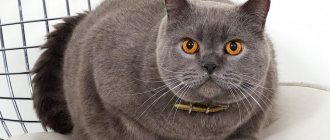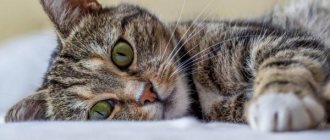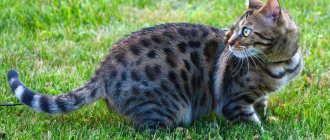The German Rex is a member of a group of cat breeds with wavy fur, as indicated by the word “rex” in its name. The very first word of the name of a breed with wavy hair indicates the place where this breed appeared.
The German Rex is an independent breed according to the criteria of most cat organizations, and only one considers this breed a variety of the Devon Rex, which is unfair because breeding work for each type of “Rex” is carried out independently.
Origin story
The first kitten with curly fur was born in Königsberg, a town in East Prussia.
It contains the blood of Russian Blue and Angora breeds. The baby was named Munch. His owners did not see anything special in their kitten, and the kitten could have continued to carelessly chase sparrows around the yard if one day an experienced breeder had not noticed him. He thought the baby looked strange and bought him from his owners. Initially, the Koenigsberg nursery took up breeding; after a while, other breeders became interested in the business. After the war, when the occupation of Germany ended, many soldiers took home curly-haired cats and cats. This is how the breed came to Europe.
In the 1970s, the breed standard was approved and it was recognized by many large felinological organizations (WCF, FIFe). The only one left out was the CFA. Members of the association considered curly-haired cats to be close relatives of the Devon Rex and refused to recognize them as a separate breed. But in the end they changed their minds.
According to another version, the ancestor of the breed was picked up on the streets of East Berlin in 1951, and her children began to participate in official breeding.
Description of the breed
The German Rex comes from Germany, but his ancestors are his mother, an Angora, and his father, a Russian blue cat.
Origin
The history of its origin began in the pre-war years in Prussia. In a small village, animals crossed, resulting in kittens with an unusual appearance. Since their owners did not understand the intricacies of cat breeds, they did not attach importance to the appearance of the offspring. By chance, a Prussian breeder saw these amazing animals with slightly curly fur. Without hesitation, he took two kittens, thanks to which a new breed arose. Subsequently, in addition to the German Rex, Devon Rex appeared.
The breeding of curly “Germans” with short hair was carried out by a nursery in Koenigsberg, which was the only one that had animals with an unusual appearance. After the occupation of the city during World War II, soldiers took home interesting kittens. This is how they spread to European countries and Russia. The breed standard was approved in the early 70s. Since then, German Rexes have participated in all large-scale exhibitions.
Appearance
Every cat has short, slightly curly hair - this is the first and most important distinguishing feature. The animals are medium in size and weigh no more than 4 kg. The body, despite its small size, is muscular and strong. The legs are high and slender, the tail is of medium length, thin, tapering towards the end.
The Herman Rex has a short, slightly curly coat that is soft and plush-like to the touch, without guard hairs. The head is oval-shaped, with highly developed cheekbones. The ears, in comparison with the head, seem very large, stand straight, not very wide, the tips are rounded. The mustache is somewhat short, also wavy, the nose is flattened, but in moderation.
The eyes are located at a normal distance relative to each other, are large, and have different colors. They can be yellow, blue, pure, without impurities of another color, to match the color of the coat.
Types of colors
There are no color restrictions for German cat breeds. It is normal for them to be one color - white, black, grayish-blue, etc. Often there are black and white cats, a combination of black and gray, red and beige, etc. There are tortoiseshell colors with different inclusions.
When participating in exhibitions, special attention is paid to the ideal combination of the color of the animal and the color of its eyes. Also an important parameter is the number of curls. It is believed that the more curls, the better the pedigree.
Character
At first, cats seem shy in the presence of new people or when moving to another place, but this is only at first. In a short period of time, they adapt without problems to any circumstances and people, beginning to show friendliness, affection and playfulness. Animals are extremely inquisitive, they are interested in everything new - real explorers.
Since the blood of the German Rex combines European aristocracy and Russian playfulness, these two features have a positive impact on the character of the breed:
- Calm and sometimes lazy, they are often very cheerful.
- They are calm about the antics of children, even if it concerns their tail.
- The animals are smart and loyal, and easily adapt to the lifestyle of their owners.
- They treat their owners like friends and often try to be like them.
- They are distinguished by their cleanliness, often licking themselves, and after use they hide their toys in places known only to them, do not break them, and treat them with care.
Pets are ready to play at any time if the owner wishes, so often mutual understanding and peace reign between animals and people in the house.
Standards
The German Rex is a cat of medium size and light weight: 3.5-5 kg.
| Standard | Description |
| Head | The skull is rounded, with a curved profile and clearly defined cheekbones. The chin is clear, strong, the ears are small, rounded at the tips and widely spaced. The nose has a barely noticeable depression at the base and is of medium length. |
| Eyes | Round, medium size, iris color - any (but must be combined with coat color). |
| Torso | Strong, with well-developed muscles, rectangular in shape. The chest is wide and rounded. |
| Limbs | Long, slender and graceful, the front ones are slightly shorter than the rear ones. |
| Tail | Most often it is neat in appearance, but it also happens with bald spots along the entire length. |
| wool | Soft and elastic, medium length. Lies in neat waves. It feels like velvet to the touch. |
Serious disadvantages of the breed:
- Bald spots on the body.
- Crooked paws.
- Close-set ears.
The curly gene is a recessive gene. Out of ignorance, cats were crossed for a long time with animals possessing other dominant genes, which is why the breed almost became extinct.
Interesting Facts
During the existence of this cat breed, many interesting things have been associated with it:
- The CFA has not yet recognized the German Rex. There they are considered a type of Devonian.
- The breed has several alternative names. Curly-haired cats are often called Prussian Rex or German Rex.
- The wavy coat is the result of a natural mutation. The gene responsible for it is considered recessive and no one can guarantee that all littermate kittens will have a curly coat.
Colors
According to the standard, different colors are allowed, including red, white, black in various variations. Cats with cinnamon, fawn, chocolate colors are not allowed to compete - i.e. colors obtained as a result of hybridization. This group also includes tabby, tricolor and bicolor.
In the photo there are cats of the German Rex breed of popular colors: red, white, black
Health and care
The beauty of caring for German Rex is that they do not require any special care. In addition, they are able to take care of themselves: German rexes do an excellent job of maintaining their fur in proper form. Owners should only help their pets maintain ear hygiene. The cat's ears need to be periodically cleaned with cotton swabs soaked in a special solution.
The German Rex is prone to obesity, at the same time, the food should have a high fat content, since due to the short hair and lack of undercoat, the German Rex quickly loses heat.
Character and behavior
The German Rex will quickly join your family and become your favorite forever. It couldn’t be any other way: these friendly and sweet cats quickly drive away the blues with their purring and cope with sadness and despondency. Their high intelligence allows them to quickly recognize the mood of the people around him, and if you are in a positive mood, the cat will invite you to play a ball with him, rolling the ball right under your feet, and if you are bored and lonely, he will climb into your arms and look sympathetically in your eyes. When rexes are happy, they express it in a way unusual for cats: by wagging their tail.
Their activity alternates with passivity and absolute relaxation. In the morning, having had a hearty breakfast, the cat is not averse to chasing around the apartment, climbing in his playground or garden trees, rustling with bags and teasing the dog on the chain.
And after lunch, lie down languidly on the windowsill and look at the sparrows dashingly jumping on the other side of the glass.
Clean and tidy kids who take care not only of themselves, but also of the order in their things. Rexes hide their toys and guard them like dogs, do not scatter the contents of the tray or food from the bowl, and wash themselves thoroughly and for a long time.
They have a pleasant melodic voice. They like to hum something under their breath, but do not shout in vain.
They love to be the center of attention and participate in all significant events in the house: be it a holiday, renovation or baking. If the whole family sits down to watch a movie on TV, they sit side by side and pretend that they are also watching. Human contact is vital for them.
Name the cat who always wanted to live together
BasilioLeopold
They love children and are always happy to play with them, but they can stand up for themselves. If a child hurts a cat, the latter will definitely let him know what he shouldn’t do, he will swing or snort, and if there is no reaction, he may even give in with his paw. Therefore, immediately explain to children that a cat is not a toy, but a living creature, and should be treated accordingly.
They quickly get accustomed to the tray and scratching post, as well as to their bed. They do not tolerate changes in conditions or surroundings well; they value tranquility and their own comfort more. Playfulness is retained until old age.
The German Rex gets along well with other pets only if it has grown up with them since childhood. In other cases, the process of addiction is long and difficult, even leading to fights and aggressive behavior.
A pet class animal costs approximately 6,000 rubles, a breed class animal costs about 8,000. The price for an exhibition animal can exceed 30 thousand rubles. In Russia, a German Rex kitten can only be purchased from private breeders (as well as in Belarus and Ukraine). Or ask for help from Devon Rex nursery owners.
Catteries for German Rex cats
Prussian rexes have a recessive “curly” gene, while in other curly-haired cats this gene is dominant, so “German” catteries are a rather rare occurrence. Basically, they can only be found in their homeland and in some other European countries.
In Russia, Ukraine and Belarus, German Rex can be found only from private breeders. It is unlikely that you will be able to find a purebred “German” in Ukraine, but you can turn to Cornish breeders. See also photos of the Cornish Rex cat.
Popular kennels for this breed:
- Russia - (your nursery is here);
- Belarus - (take place);
- Ukraine - (submit an application).
Care instructions
The absence of undercoat is only beneficial for the owner. This makes care easier, since there is no need to frequently comb the cat, sort out tangles and buy a variety of brushes. You only need one – with natural bristles. Brush your pet once a week gently and gently, moving from head to tail.
Bathing
Problems often arise with bathing: rexes do not like water procedures. Therefore, if your pet is very dirty and is not able to wash himself with his tongue, prepare in advance.
Buy a special cat shampoo (human shampoo is not suitable: they cause allergies and intestinal dysfunction), lay a thick diaper on the bottom of the bath (so that the cat, feeling the emphasis under its paws, clings to it with its claws and is not so afraid) and call one of the household members can I help you.
During the procedure, water and soap should not get into the cat’s ears, so put a bathing cap on him or cover the ear canals with cotton swabs. If the house is warm, you can let the cat dry on its own. If not, use a hairdryer or dry the cat with a towel.
Ears
Rex cats' ears are examined weekly, and excess wax is removed with cotton pads soaked in ear lotion or boiled water.
Teeth
Teeth also require regular care. In the wild, animals clean them on their own, but at home they need your help. Buy cat toothpaste and a brush at the pet store (instead of a special cat brush, you can use a regular baby brush, shortening its bristles). Popular companies: Trixie, Beaphar Toothpaste, Hartz.
Expert opinion
Dusheba Vera Ivanovna
In 2010, she graduated from the Moscow State Academy of Veterinary Medicine named after K.I. Scriabin with honors, specializing in veterinary medicine. I regularly attend veterinary conferences, congresses, and webinars.
It happens that a cat categorically refuses to brush his teeth, bites, spits and kicks. From fear, he can scratch you severely and even bite your hands. In this case, you can use liquid cleaning gels that are added to drinking water, as well as dry pads to remove plaque. In this case, you will have to take the animal to the veterinary clinic once a year for cleaning under anesthesia.
Claws
The Rex's claws are sharpened on their own, and if you don't want your furniture or walls to be damaged, buy your cat a comfortable scratching post: made of natural, well-treated wood, or thick cardboard, covered with rope, carpet or sisal fabric. The scratching post should be the size of your pet or slightly larger. It is advisable to buy several pieces and install them in different rooms.
Feeding the cat
To maintain activity, German Rex cats need a balanced diet. And to compensate for heat loss, the menu of cats of this breed should contain a sufficient amount of fat.
To save time, your German Rex can be given ready-made food. When choosing drying, it is advisable to give preference to premium or super premium products. It has a balanced composition and contains all the necessary vitamins and minerals. The following brands of food best meet these requirements:
- Arden Grange;
- Hills;
- Pronature;
- Brit Care.
With a natural type of nutrition, the diet of the German Rex is designed so that fresh meat predominates in it. The cat is also given porridge, vegetables, fermented milk, eggs, ocean fish and offal.
To keep your German Rex healthy longer, it should not be fed pork, sweets, baked goods, sausages or beans. Also, the cat is prohibited from giving river fish, bones, whole milk, starchy vegetables, exotic fruits and any food from the owner’s table.
Catering
The special structure of the kidneys allows cats to drink less than humans. But the water in their drinking bowl should also be clean and fresh. You cannot pour water from the tap: it contains many undesirable elements that are safe for humans, but dangerous for animals. Therefore, use special filters to purify moisture, or leave it in an open jar for at least 12 hours. You can also buy bottled water.
Natural products
The food on your table is not suitable for your cat. She is not allowed much. Sweet, salty, pickled, smoked, fried, baked, flour, food with seasonings and sauces - the list is long! Products containing cocoa beans do not decompose in the animal’s body, but accumulate in the liver and lead to poisoning.
The same applies to beer and other alcoholic drinks. Tea (both black and green) cause disturbances in the cardiovascular system, potatoes and tomatoes - the gastrointestinal tract, onions and garlic cause anemia, avocados, grapes, raisins and eggplants - vomiting and diarrhea, boiled bones can injure the intestines , pierce it.
Some foods are not prohibited, but are undesirable. These are legumes (cause fermentation), sunflower seeds, pasta, baked goods, condensed milk, pork, sea fish, whole cow's milk, chicken protein, raw eggs, goose and duck meat, raw liver, dog food and human vitamins.
The diet should include:
- Fresh meat: beef, rabbit, veal, turkey and lamb. It is cut into small pieces (grinding into minced meat is only permissible for children and animals without teeth) and scalded with boiling water.
- Chicken and beef by-products: kidneys, liver, hearts. They are boiled or stewed.
- Sea fish: hake, trout, salmon, halibut. You can give boiled shrimp and squid once a week. You should not give fish more than once a week, otherwise your cat will develop kidney problems as she ages.
- Dairy products: cheese (unsalted hard varieties), kefir, yogurt, fermented baked milk, cottage cheese. Natural yogurt is also allowed, which does not contain chemical preservatives, flavor enhancers or dyes.
- Vegetable oil: olive, sunflower, flaxseed, butter. Add half a teaspoon to the porridge daily.
- Boiled chicken protein, quail eggs.
- Porridges cooked in water: rice, corn, millet, buckwheat, oatmeal, millet. You can also add vegetables there: green beans, cauliflower, carrots, pumpkin, zucchini, greens (spinach, dill, parsley, green salad).
- Cats can be given apples, melons, pears, and corn as treats.
Vitamin complexes won't hurt either. Choose high-quality multivitamins, as well as supplements containing phosphorus, calcium and other beneficial microelements.
Recommended food
From ready-made food, both breeders and veterinarians advise giving animals holistic food: Acana, Farmina N&D, Wildcat. For their production, good quality products are used, and the composition speaks for itself: a sufficient amount of meat, fish, dried berries and vegetables, vitamin and mineral supplements, natural preservatives.
In economy and premium food, the only advantage is the low price. The composition raises many questions. Firstly, the packaging does not indicate specific meat, but “meat waste”. What is hidden behind this phrase is unknown. Plant ingredients - specifically corn gluten - often cause allergic reactions. There are very few vitamins and minerals, but there are enough dyes and preservatives of artificial origin, which has an extremely negative impact on the health of animals.
Below are the recommended holistic and super-premium foods. Links with the names of the food are clickable, on them you can, within our website, get acquainted with the descriptions of the food and read reviews from owners of German Rex cats.
| Holistic | Super premium | Super premium |
| Primordial | SUPERPET | Organix |
Features of feeding and diet
German Rexes have an excellent appetite and will eat anything. The ideal solution is to feed animals natural food, adding the following products to the daily diet:
- yogurt, sour cream, low-fat cottage cheese;
- boiled and raw beef, chicken;
- sea fish without bones;
- offal;
- boiled vegetables;
- cereal porridge;
- fresh eggs.
It is not recommended to feed your omnivorous pet greens, berries and some fruits, especially sour ones. It is not recommended to give your German Rex:
- sausages, sausages;
- skin, bones;
- smoked, fried, spicy foods;
- all flour, sweets.
Since animals are prone to obesity, they need to be fed rationed. Small kittens require frequent feeding - up to 5 times a day, “teenagers” - 3 times a day, adult cats - up to 2 times.
The serving size will determine the pet's weight. The optimal rate is calculated using the formula: the weight of the animal is multiplied by 5%. So, a 4-kilogram cat should be given no more than 200 grams of food per day.
The weight of dry food should be half as much, since it is supplemented with water and swells in the stomach. A table with standards is usually printed on the packaging. Dry food is an excellent choice if you don’t have time to cook or are afraid of creating a natural menu incorrectly.
Diseases
The German Rex is destined for a long life. With good care, he will easily overcome the bar of 15, or even 18 years. But some specific features are also inherent in this breed.
- Since the Rex has no undercoat, it is dangerous to leave it in drafts and walk it in low temperatures. Children and elderly people catch colds especially often. After bathing, you should thoroughly dry the animal, and for walks in the cold season, dress the cat in blouses that fit (by the way, such clothes can be easily bought at any pet store). The bed should not be installed near doors and windows.
- The tendency to overeat is another scourge of the German Rex. They will “give their souls” for a tasty piece, which means that from childhood they should be taught a certain diet. Snacking between meals is prohibited!
- These cats will not drink cloudy water: even if there is only one speck of dust floating on the surface, the cat will see it and will either look for another source or tolerate it. And lack of water is a prerequisite for the development of urolithiasis.
Naturally, vaccinations and deworming are mandatory, even if your cat does not go outside at all. Viral diseases can enter your home through other means than personal contact, so follow a schedule of procedures.
Table: pros and cons of the breed
| pros | Minuses |
| Attractive appearance | Rarity of the breed in our country |
| High intelligence and obedience | Talkativeness and playfulness can sometimes be excessive |
| Loyalty and love for the owner and his family members | Intolerance to change |
| Cleanliness and neatness | Intolerance of loneliness |
| Ease of care | Love for owners borders on obsession |
| Good health and strong immunity | Possible hair problems (baldness) |
| Affordable price of kittens | Excessive curiosity and entrepreneurship |
Thus, the German Rex can be safely called an ideal pet for families with children, because it is one of the best companions: playful, with an active lifestyle and completely non-aggressive. In terms of devotion and love for the owner, representatives of this breed have no equal, and they are also clean, smart and obedient, unpretentious in matters of nutrition and grooming. The only problem is to find such a kitten in Russia. It is easier to purchase it in another country - Germany or Holland.
How to choose a long-haired kitten
Based on the appearance of a newborn kitten, it is difficult to independently determine its breed qualities and developmental characteristics. Therefore, it is worth using the recommendations of experienced breeders.
- A purebred longhaired kitten should only be purchased from a reputable breeder or cattery with a good reputation.
- You should definitely meet the baby’s parents. No one better illustrates the appearance of the offspring than his ancestors.
- If possible, you should visit kittens to observe their behavior, games and character.
- It is important to remember that not only people choose cats, but animals also look closely at humans in advance. It is best to take exactly the kitten that independently approaches your hand and tries to attract attention.
- In a good nursery, they are not allowed to take away young animals before the babies have undergone initial veterinary procedures (vaccination and deworming).
But it is impossible to understand the quality of long hair in childhood. When we are talking about representatives of a certain breed, and the kitten’s parents do not raise doubts about their breeding origin, there is no need to worry. The animal will certainly inherit a beautiful coat and, over time, acquire a decent appearance.
As for mixed-breed or outbred cats, the task becomes more complicated. In early childhood, all kittens are fluffy. You can figure out which of them will be long-haired and which will remain smooth only after meeting the parents.
- Two long-haired representatives will certainly give birth to offspring with the same characteristics.
- Short-haired parents do not produce long-haired kittens.
- Mixed matings (short and long hair) are a lottery. There will be two types of kittens in the litter, and no expert can predict their appearance.
This is interesting! The hereditary genetics of cats is such that they cannot skip a generation in terms of coat characteristics and pass on the appearance from grandfather to grandson. Therefore, one look at the kitten's parents will be enough to determine how long its fur will be.
Vaccinations and antiparasitic treatment
To prevent viral and infectious diseases, German rex dogs are systematically subjected to routine vaccination. At the age of 7-8 weeks, a German kitten is vaccinated with a complex drug that stimulates the development of immunity to panleukopenia, rhinotracheitis and calcivirosis.
After 28 days he is vaccinated against the same diseases and against rabies. In the future, German Rex is vaccinated annually.
To prevent the development of diseases carried by parasites, the cat is periodically treated for fleas and helminths. Antihelminthic drugs are given to German Rex twice a year with mandatory repetition after 10-14 days. The dosage is selected strictly according to the weight of the German cat.
To combat fleas, use special drops or shampoos. And if the German Rex is outside, he is put on an anti-parasitic collar.











